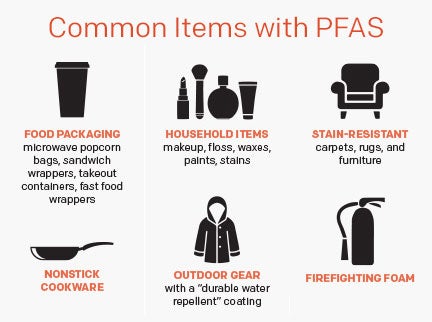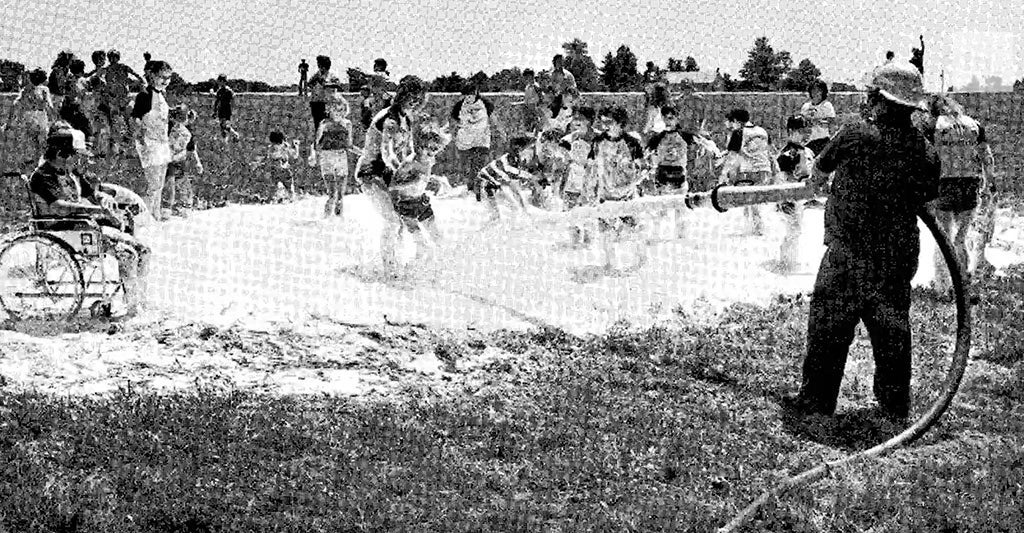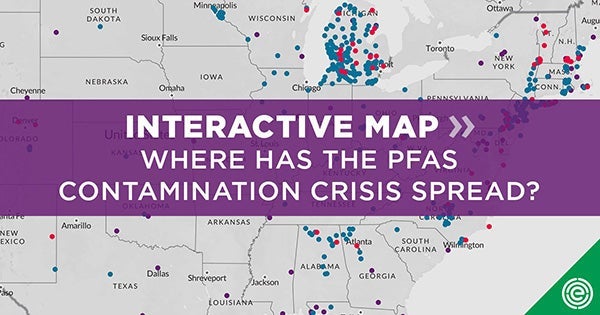What PFAS are, why they’re harmful, and what we can do to protect ourselves from them

Toxic “forever chemicals” known as PFAS are linked to several harmful health impacts and have contaminated drinking water sources across the country. PFAS are found in everyday products like waterproof jackets, food packaging, and nonstick pans. They’re also found in a majority of the U.S. population.
Learn what PFAS are, why they’re harmful, and what Earthjustice is doing to protect us all from these toxic chemicals.
What are PFAS?
“PFAS” is short for per- and poly-fluoroalkyl substances. They are a class of more than 15,000 chemicals that help materials repel water, grease, and stains.
PFAS don't easily break down and can persist in our bodies and the environment for decades. Today, more than 97% of the U.S. population have PFAS in their bloodstream.

Why are PFAS harmful?
Chemical manufacturers, like DuPont and 3M covered up evidence, of the dangerous human health and environmental impacts of PFAS for decades.
We now know that much research links PFAS exposure to a wide range of serious health issues, including kidney and testicular cancer, endocrine disruption, and immune system suppression. Communities with highly PFAS-contaminated water like those who live in the Cape Fear River basin of North Carolina have experienced unusual clusters of serious medical effects.
Wildlife is also impacted by PFAS, with one major study finding that more than 600 species are at risk of harm from PFAS exposure. This first-time analysis found studies that linked PFAS exposure in a wide range of species to liver damage, developmental and reproductive issues, and nervous and endocrine system impacts.
How am I exposed to PFAS?
Drinking water is one of the most significant pathways of PFAS exposure. According to government scientists, at least 45% of the nation’s tap water is estimated to contain one or more PFAS.
PFAS contaminate water supplies through many sources. One is PFAS-containing firefighting foam, which the U.S. military has used for decades in training exercises at hundreds of bases nationwide. Another is industrial processes like textile and chemical manufacturing, which create PFAS-contaminated wastewater that is often dumped into nearby water bodies.
People who live near industrial sites that manufacture or process PFAS can also be exposed through PFAS-contaminated air that later deposits into the soil. Environmental contamination of soil and water can lead to dangerously high levels of PFAS in certain foods, such as freshwater fish.
Finally, PFAS chemicals, which help materials repel water, grease, and stains, are found in a wide range of consumer products. These include non-stick cookware, food packaging, stain-resistant fabrics (such as those used in upholstered furniture), carpets, plastic packaging, and textiles like outdoor clothing and raingear. Even personal care products like waterproof mascaras, eyeliners, sunscreen, shampoo, and shaving cream can contain PFAS.

How can I reduce my exposure to PFAS?
PFAS are ubiquitous throughout our environment, which makes them particularly difficult for individuals to avoid. That’s why we need robust laws at the federal and state level to protect all of us from PFAS contamination.
That said, individuals can reduce their exposure to PFAS through a number of actions, including the use of a water filtration system certified to lower the levels of PFAS in water. The American Academy of Pediatrics also recommends that families can limit their PFAS exposure by:
- routine wet dusting/mopping in the home to get rid of household dust that may contain PFAS;
- cutting back on certain fast food containers, such as microwave popcorn packaging;
- replacing old and/or flaking nonstick cookware; and
- checking local fish, wildlife, meat, and dairy advisories if consuming locally-sourced foods.
The Environmental Working Group also has a guide to avoiding PFAS.
What are regulators doing about PFAS?
For decades, the federal government has underregulated PFAS, much to the dismay of top scientists and health advocates around the world.
Luckily, several states have taken the lead in addressing PFAS through a precautionary approach that follows the science by presuming that as a class of chemicals, PFAS are too dangerous to use and therefore should be minimized as much as possible.
- For example, Maine and Minnesota have recently passed sweeping prohibitions on PFAS in consumer products unless their use in those products is found to be essential.
- Several other states have passed bans on PFAS as a class in multiple categories of consumer products, including California, Colorado, New York, and Washington state.
On the federal level, government agencies are finally taking critical first steps in regulating PFAS after years of litigation and community advocacy. Two of the most significant happened in early 2024, when the U.S. Environmental Protection Agency,
- finalized the first ever drinking water standards for six toxic PFAS, and
- designated two of the most prevalent PFAS in the environment, PFOA and PFOS, as hazardous substances under the Superfund law.
Learn about EPA’s roadmap on PFAS and the status of individual actions.

What’s Earthjustice doing?
Earthjustice believes that lawmakers should take a class-based and precautionary approach to regulating all dangerous chemicals, including PFAS, in order to protect communities from chemical exposure through air, water, and soil.
Since PFAS contamination is a multi-faceted problem, we’re pushing for multi-faceted solutions, including:
- Stopping the flow of new PFAS chemicals into the market
In May 2023, the EPA proposed a rule to close one of the biggest regulatory loopholes in the Toxic Substances Control Act (TSCA) after Earthjustice petitioned the EPA on behalf of community organizations, first responders, and environmental advocates in 2021. In April 2024, Earthjustice also petitioned the EPA to regulate PFAS in plastic containers. Every year, hundreds of millions of plastic containers that store various products — including household cleaning products, fuels, and pesticides — undergo a fluorination process that creates multiple long-chain PFAS, posing risks to consumers, workers, and the environment. - Protecting communities from dangerous PFAS incineration
In 2023, Earthjustice reached a settlement agreement with the Department of Defense to terminate its contracts to burn millions of gallons of unused PFAS-containing firefighting foam in places like in East Liverpool, Ohio; Arkadelphia and El Dorado, Arkansas; and Cohoes, New York. Incinerating these chemicals can actually create additional PFAS and other toxic chemicals, yet the DOD awarded its contracts without the required environmental review and incinerated PFAS in violation of certain legal requirements. - Strengthening regulations of PFAS discharges to surface water
Earthjustice is advocating for communities alongside grassroots, health, and environmental organizations to establish standards under the Clean Water Act to prevent industrial polluters from sending PFAS-contaminated wastewater to treatment plants that cannot remove PFAS effectively. In Colorado, for example, we’re challenging a water discharge permit for having weak PFAS protections. In Washington state, Earthjustice is advocating for more stringent pollution controls for a wastewater treatment plant that is threatening salmon, orcas, and people by discharging PFAS-contaminated wastewater. And in New York, Earthjustice is commenting on Clean Water Act permits and working with state legislators to advocate for limits on PFAS discharges to surface water. - Pressing for stronger state-based standards
Earthjustice is working in several states like New York, Colorado, and Illinois to advocate for the adoption of stronger laws and policies regarding PFAS. For example, after dedicated Earthjustice advocacy, New York State passed a groundbreaking drinking water standard in 2020 that requires regulators to test for and remove two common PFAS chemicals. - Defending the public’s right to know about PFAS releases
Earthjustice has successfully pushed the EPA to adopt regulations that add hundreds of PFAS to the Toxics Release Inventory, a searchable, online database of chemical releases and disposal. We then forced the EPA in 2023 to eliminate reporting loopholes that allowed polluters to avoid disclosing their PFAS emissions, and we will continue to urge the EPA to add additional PFAS to the reporting database. - Obtaining health screenings for communities impacted by PFAS
Earthjustice has successfully advocated on behalf of communities affected by PFAS to ensure they can sue the polluters for regular health screenings, at the expense of the polluters. These screenings are designed to identify PFAS-linked diseases at early stages, when they are most treatable.
Jessica A. Knoblauch is a senior staff writer with Earthjustice and a former award-winning journalist. She enjoys wild places and dispensing justice, so she considers her job here to be a pretty amazing fit.
Established in 1989, Earthjustice's Policy & Legislation team works with champions in Congress to craft legislation that supports and extends our legal gains.
Earthjustice’s Toxic Exposure & Health Program uses the power of the law to ensure that all people have safe workplaces, neighborhoods, and schools; have access to safe drinking water and food; and live in homes that are free of hazardous chemicals.
